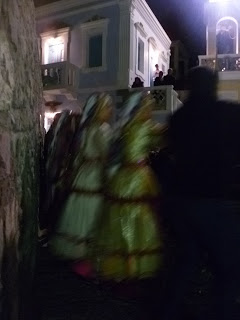The biggest day of Easter in Olympos is Lambri Triti, Bright Tuesday. In the morning, the bells start to ring
and a few men carry the large icons out of the church and
around the village, stopping at different chapels with the priest before
gradually making their way down to the cemetery. There, he'll bless the family graves. The women wear their best traditional dress, bright stiff skirts and puffy sleeves in an almost Elizabethan style with much sparkling trim; it's a striking scene, a big draw for photographers. Last year, when I followed the procession I felt very conscious that we small group of tourists looked like scruffy papparazzi.
There again, as I said to Raymond from northern France yesterday
evening, the locals take photographs of their cultural events just as much as
the outsiders do. Raymond, carrying a fairly big camera, had been expressing similar concern about the number
of photographers jostling for
position. Yet all the village kafeneia have their walls covered in photos from
years and decades past, a document of village life. There were mobile phones
aplenty recording the musicians playing in the square, and at one point we laughed
as a local young woman in full traditional dress held two mobile phones to
record the proceedings – capturing footage of us in the process.
Last year, it had been too cold for the music to happen in
the square in the evening – it was moved to a hall at the edge of the village and happened very late – so it was a treat to experience yesterday. In the afternoon
someone was playing tsambouna, the
goatskin bagpipe, in the Zografidis kafeneio. A little later,
tables were set up outside and a small group of men old and young sang mantinades, improvised verses, to music
played on laouto and lyra. Every now and then a fresh whisky bottle appeared on
the table. The mantinades, the few I
could understand, tended to be about how they appreciated one another’s company
and how good it was to celebrate together.
Gradually more and more people gathered around the company to
listen, as the sun went down and the night wore on. A cold wind blew off the
sea and the mountain but the musicians were kept warm by the crowd gathered around,
and perhaps the Johnny Walker. The men on the lyra and laouto were replaced by younger men, whose fingers never left the instruments - one of the nearby men placed cigarettes and cups of whisky to their lips.
A few men and then women began to dance – less of a dance than a very slow shuffle around the table. More hours passed. Finally, after
midnight, came the moment we’d all been waiting for, and everyone moved up the
steps to the square in front of the church, where there was more room for
everyone to join in the dancing.
The men who led the dance displayed some flamboyant leaps and
moves. For most of the rest of the circle clasping hands, it was the same tiny,
subtle, bouncy steps for what seemed like hour upon hour, though towards the
end there was a break towards something livelier. Then the party broke up
around 4 a.m., and the village went to sleep.
Check out photographs from last Lambri Triti by my friend Michael Pappas:











I'm really falling more deeply in love with Karpathos from your sharing. It's funny, because long before you moved there, I'd just heard the name scanning a map and it had given me that special tingle. Now having read your blogs, I really plan on going. I think Easter must really be something in Greece, probably more than most other countries for some reason.
ReplyDeleteThank you, Jan - that is very good to hear! Maybe next Easter you can come and stay in Olympos...?! Though it can be quite cold there at Easter sometimes. It's great in September/October - still warm, but quiet. Yes, Easter is huge in Greece, partly as the start of summer - and it's still quite a religious country really.
Delete